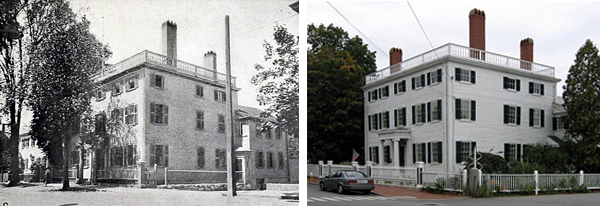Nathaniel Adams, the Portsmouth chronicler who published the Annals of Portsmouth in 1825, is thought to have been born in a home near the corner of Pleasant and State Streets. His father, also Nathaniel Adams, owned the land where the Exchange Block sits today. After the Great Portsmouth Fire of 1813 destroyed the Adams’ home as well as other buildings in this area, the current Exchange Block was built. The commercial building was later extensively remodeled during the 1890s.
D. H. (David Henry) Montgomery founded Montgomery’s Music and Art Store at the north end of the Exchange Block in 1862, just when the American Civil War was heating up. He became the sole agent in Portsmouth of Knabe pianos from Germany, and his showroom included pianos by Chickering, Ives & Pond, Briggs, and Vose. He also carried organs by Mason & Hamlin, Wilcox & White, and the Smith American Organ Company.
D. H. Montgomery built a modest home on the corner of Merrimac Street and Miller Avenue in 1880. A later owner extensively remodeled and expanded the building, and it is now known as the Montgomery-Eldredge House. When D. H. Montgomery died in 1885, his son, Horace P. Montgomery, became the store’s owner and manager.
Montgomery's Music and Art Store ran the above advertisement in The Portsmouth Directory of 1905, and the shop was listed under the following categories: Artists’ Materials; Cameras; Engravings, Pictures, Etc.; Music and Musical Instruments; Photographic Supplies; Piano and Organ Tuning; Pianos and Organs; Picture Framing; Pictures and Picture Frames.
On the floors above Montgomery's shop were the publishing offices of three Portsmouth newspapers: a morning edition called the Chronicle, first published in 1852; an evening edition called the Herald, previously known as the Penny Post; and the weekly New Hampshire Gazette, the oldest newspaper in the United States.
According to Portsmouth’s annual reports, Montgomery’s Music and Art Store was in business at least through 1923, when the city paid H. P. Montgomery $14.50 for music.
The vintage photographs above were published in C. S. Gurney's 1902 book, Portsmouth . . . Historic and Picturesque. The Piscataqua Savings Bank moved into the space once occupied by Montgomery’s Music and Art Store around 1924 and has been located there ever since.
















